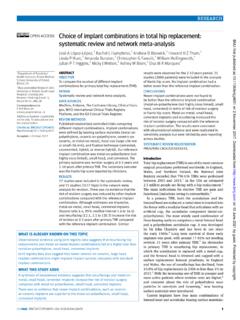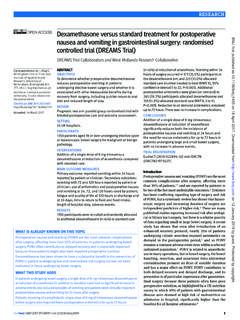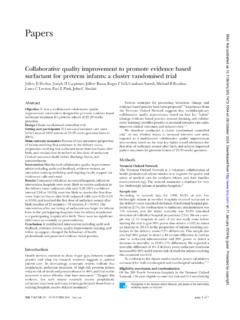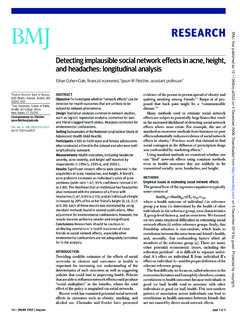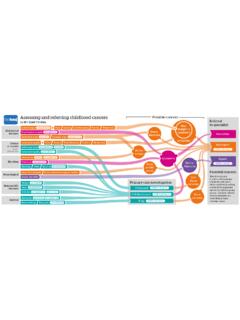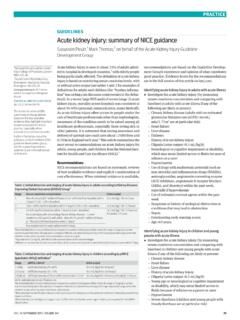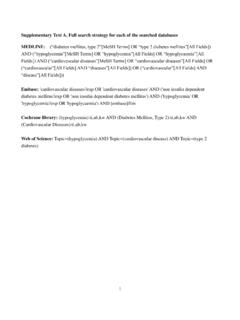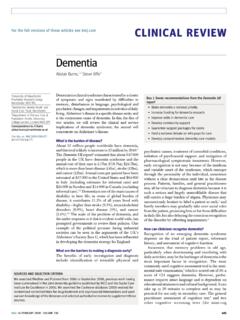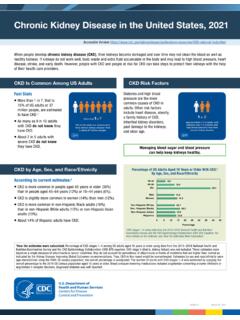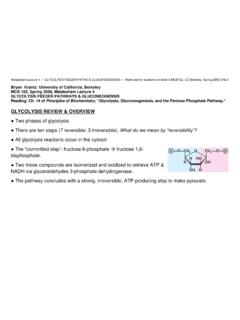Transcription of Long covid mechanisms, risk factors, and management
1 STATE OF THE ART REVIEWthe bmj | BMJ 2021;374:n1648 | doi: 1 Long covid mechanisms, risk factors, and managementHarry Crook,1 Sanara Raza,1 Joseph Nowell,1 Megan Young,1 Paul Edison1,21 Faculty of Medicine, Imperial College London, London, UK2 Cardiff University, Cardiff, UKCorrespondence to: P Edison this as: BMJ 2021;374:n1648 explanation: State of the Art Reviews are commissioned on the basis of their relevance to academics and specialists in the US and internationally. For this reason they are written predominantly by US disease 2019 ( covid -19) has spread across the world. As of 4 July 2021, more than 183 million confirmed cases of covid -19 have been recorded worldwide, and more than million deaths have been reported by the World Health Organization .1 The clinical spectrum of covid -19 ranges from asymptomatic infection to fatal 3 The virus responsible for causing covid -19, severe acute respiratory syndrome coronavirus 2 (SARS-CoV-2), enters cells via the angiotensin- converting enzyme 2 (ACE2)
2 Once internalized, the virus undergoes replication and maturation, provoking an inflammatory response that involves the activation and infiltration of immune cells by various cytokines in some The ACE2 receptor is present in numerous cell types throughout the human body, including in the oral and nasal mucosa, lungs, heart, gastrointestinal tract, liver, kidneys, spleen, brain, and arterial and venous endothelial cells, highlighting how SARS-CoV-2 can cause damage to multiple 7 The impact of covid -19 thus far has been unparalleled, and long term symptoms could have a further devastating Recent evidence shows that a range of symptoms can remain after the clearance of the acute infection in many people who have had covid -19, and this condition is known as long covid .
3 The National Institute for Health and Care Excellence (NICE) defines long covid as the symptoms that continue or develop after acute covid -19 infection and which cannot be explained by an alternative diagnosis. This term includes ongoing symptomatic covid -19, from four to 12 weeks post-infection, and post- covid -19 syndrome, beyond 12 weeks Conversely, The National Institutes of Health (NIH) uses the US Centers for Disease Control and Prevention (CDC) definition of long covid , which describes the condition as sequelae that extend beyond four weeks after initial People with long covid exhibit involvement and impairment in the structure and function of multiple Numerous symptoms of long covid have been reported and attributed to various organs, an overview of which can be seen in fig 1.
4 Long term symptoms following covid -19 have been observed across the spectrum of disease severity. This review examines the long term impact of symptoms reported following covid -19 infection and discusses the current epidemiological understanding of long covid , the risk factors that may predispose a person to develop the condition, and the treatment and management guidelines aimed at treating it. ABSTRACTS ince its emergence in Wuhan, China, covid -19 has spread and had a profound effect on the lives and health of people around the globe. As of 4 July 2021, more than 183 million confirmed cases of covid -19 had been recorded worldwide, and million deaths. Recent evidence has shown that a range of persistent symptoms can remain long after the acute SARS-CoV-2 infection, and this condition is now coined long covid by recognized research institutes. Studies have shown that long covid can affect the whole spectrum of people with covid -19, from those with very mild acute disease to the most severe forms.
5 Like acute covid -19, long covid can involve multiple organs and can affect many systems including, but not limited to, the respiratory, cardiovascular, neurological, gastrointestinal, and musculoskeletal systems. The symptoms of long covid include fatigue, dyspnea, cardiac abnormalities, cognitive impairment, sleep disturbances, symptoms of post-traumatic stress disorder, muscle pain, concentration problems, and headache. This review summarizes studies of the long term effects of covid -19 in hospitalized and non-hospitalized patients and describes the persistent symptoms they endure. Risk factors for acute covid -19 and long covid and possible therapeutic options are also discussed. on 20 January 2022 by guest. Protected by : first published as on 26 July 2021. Downloaded from STATE OF THE ART REVIEW2 doi: | BMJ 2021;374:n1648 | the bmjMethodsWe searched PubMed and Embase databases for articles published between January 2020 and May 2021.
6 Our search terms were long covid or post- covid -19 or covid long-haulers or SARS-CoV-2 and epidemiology or fatigue or fatigue syndrome or dyspnoea or breathlessness or shortness of breath or cardiac or cardiovascular or heart or cognition or cognitive impairment or mental health or depression or anxiety or psychiatric or central nervous system or autonomic nervous system or isolation or loneliness or sleeplessness or sleep or smell or taste or olfactory or gustatory or risk factors or treatment . To avoid unintentionally removing articles, no filters were applied. We retrieved 61 881 articles in the first instance. To screen articles, titles were read by authors first, followed by abstracts to further narrow down the number of records considered.
7 To avoid unnecessary exclusion of studies, limited exclusion and inclusion criteria were applied. We excluded papers that were not relevant to or did not mention long covid , while studies mentioning long covid in any capacity were initially included owing to the novelty of the field. Furthermore, we considered long covid studies regardless of their cohort sizes or study design. We discovered and read fully 227 articles on long covid , and we discussed each to determine which would be included in the finalized article. We performed further manual searching for additional articles and treatment guidelines using relevant databases, including and In total, 218 references were included. Studies examining long covid are limited, therefore limited exclusion criteria were of long covidStudies have assessed people who have had covid -19 to examine the symptoms associated with long covid .
8 $&( $&( $&( $&( $&( $&( $&( $&( $&( .LGQH\ 5 HQDO LPSDLUPHQW $FXWH NLGQH\ LQMXU\3 DQFUHDV 3 DQFUHDWLF LQMXU\ 3 DQFUHDWLWLV+HDUW &KHVW SDLQV 0\RFDUGLDO LQ DPPDWLRQ 6 HUXP WURSRQLQ 3 DOSLWDWLRQV%UDLQ %UDLQ IRJ 'HOLULXP )DWLJXH 6 OHHS GLVWXUEDQFHV 'HSUHVVLRQ DQ[LHW\ 376' 2&66 SOHHQ 7 % O\PSKRF\WH $WURSK\ RI O\PSKRLG IROOLFOHV/LYHU /LYHU LQMXU\ $VSDUWDWH DPLQRWUDQVIHUDVH $ODQLQH DPLQRWUDQVIHUDVH%ORRG YHVVHOV ,Q DPPDWLRQ 9 HVVHO GDPDJH &RDJXORSDWK\ 0 LFURDQJLRSDWK\*DVWURLQWHVWLQDO WUDFW 'LDUUKHD 1 DXVHD 6 RUH WKURDW/XQJV '\VSQHD &KHVW SDLQ &RXJKFig 1 | Multi-organ complications of covid -19 and long covid . The SARS-CoV-2 virus gains entry into the cells of multiple organs via the ACE2 receptor. Once these cells have been invaded, the virus can cause a multitude of damage ultimately leading to numerous persistent symptoms, some of which are outlined here on 20 January 2022 by guest. Protected by : first published as on 26 July 2021.))))))))]
9 Downloaded from STATE OF THE ART REVIEWthe bmj | BMJ 2021;374:n1648 | doi: 3 These studies are summarized in table 1. The articles included throughout this review were selected in favor of quality, with large observational studies of greatest interest. Most of the studies included are cross-sectional or cohort observational studies with large cohorts; however, because of the novelty of the disease and paucity of data, studies involving smaller cohorts and case series were also included. Any patient with covid -19 may develop long covid , regardless of the severity of their infection and the intensity of the treatment they received. Patients treated on wards and intensive care units (ICUs) show little difference in incidence of long term symptoms associated with The proportion of people that develop long covid symptoms, whether they are treated with oxygen alone, with continuous positive airway pressure, or with invasive ventilation, is Many patients with mild acute symptoms also develop long covid symptoms,13 in fact, studies show minimal differences between the prevalence of long covid symptoms between hospitalized and non-hospitalized covid -19 reported incidence and mortality rates of covid -19 vary between countries, making it difficult to accurately predict the number of patients who will progress to long covid .
10 Similarly, the accurate reporting of long covid is complicated. The disparity in this epidemiological data is likely the result of several factors, including differences in the base population, the accuracy of diagnosis, the reporting systems, and the capability of healthcare systems. Although determining the exact epidemiological data of long covid is difficult, this information is needed to inform healthcare systems and governments when developing support and treatment algorithms. The volume of published literature describing cases of patients with covid -19 who subsequently develop long covid symptoms is continually growing, which will allow for an improved understanding of its current disparities between long covid epidemiology reporting are owing to many reasons, including the length of follow-up period, population assessed, accuracy of self-reporting, and symptoms examined.


